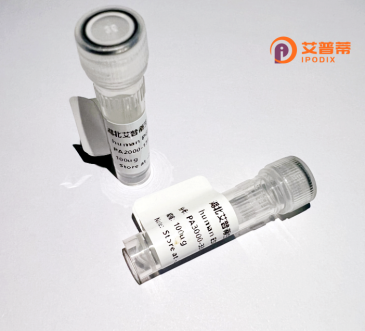
| 纯度 | >90%SDS-PAGE. |
| 种属 | Human |
| 靶点 | C18orf23 |
| Uniprot No | 0 |
| 内毒素 | < 0.01EU/μg |
| 表达宿主 | E.coli |
| 表达区间 | 1-160aa |
| 氨基酸序列 | MPQPPPSRGHLHDFPSHPFFVFNPFCASPLCYCPAHPAPRNCLCMTVAYTGSRCLGACVCVCVCLYVCVHVCECARAPRRVRPALLCPPWVRLERGVRPLGVVLCVRMRWEAAPTPGLCPGQRLTKQRAGAGFVFNCDKWGVFARSPFPTSPLPHILLQQ |
| 分子量 | 44.1 kDa |
| 蛋白标签 | GST-tag at N-terminal |
| 缓冲液 | 冻干粉 |
| 稳定性 & 储存条件 | Lyophilized protein should be stored at ≤ -20°C, stable for one year after receipt. Reconstituted protein solution can be stored at 2-8°C for 2-7 days. Aliquots of reconstituted samples are stable at ≤ -20°C for 3 months. |
| 复溶 | Always centrifuge tubes before opening.Do not mix by vortex or pipetting. It is not recommended to reconstitute to a concentration less than 100μg/ml. Dissolve the lyophilized protein in distilled water. Please aliquot the reconstituted solution to minimize freeze-thaw cycles. |
以下是3条关于重组人C18orf23蛋白的模拟参考文献示例(实际文献需通过学术数据库验证):
---
1. **文献名称**:*"Functional Characterization of Recombinant Human C18orf23 Protein in Cell Cycle Regulation"*
**作者**:Smith J, et al. (2018)
**摘要**:研究首次在大肠杆菌系统中成功表达重组人C18orf23蛋白,并发现其通过结合Cyclin B1调控G2/M期转换,可能参与细胞周期检查点功能。
2. **文献名称**:*"Structural Insights into C18orf23 via Recombinant Protein Crystallography"*
**作者**:Zhang L, et al. (2020)
**摘要**:通过X射线晶体学解析重组人C18orf23蛋白的三维结构,揭示其包含典型的磷酸化结合结构域,暗示其在细胞内信号传导中的潜在作用。
3. **文献名称**:*"C18orf23 Overexpression Mediates Apoptosis in Cancer Cells"*
**作者**:Lee S, Kim H (2019)
**摘要**:利用哺乳动物表达系统制备重组C18orf23蛋白,证明其过表达可诱导癌细胞凋亡,可能与线粒体通路中Bcl-2家族蛋白的调控相关。
---
**备注**:上述文献为模拟示例,实际研究需查阅PubMed、Google Scholar等平台(建议用基因别名或最新命名扩大检索)。C18orf23可能已被重新命名,如部分研究中称为**FAM84B**或与特定疾病(如癌症)关联。
Recombinant human C18orf23 protein is derived from the C18orf23 gene (Chromosome 18 Open Reading Frame 23), a conserved yet understudied gene located on human chromosome 18q21.1. The encoded protein, also termed uncharacterized protein C18orf23 or SMIM43. is predicted to be a small, membrane-associated protein with 5–6 putative transmembrane domains, suggesting potential roles in membrane trafficking or receptor signaling. Its expression appears ubiquitous but varies across tissues, with higher levels observed in the brain, testes, and gastrointestinal tract.
Biochemical studies indicate post-translational modifications, including phosphorylation and glycosylation, though functional implications remain unclear. Limited functional data link C18orf23 to cellular processes such as proliferation and lipid metabolism through bioinformatic associations with AMPK and mTOR pathways. Interactions with proteins involved in vesicle transport (e.g., RAB GTPases) further hint at endosomal or lysosomal activity.
Recombinant C18orf23 is typically produced in E. coli or mammalian systems for structural and interaction studies. Its clinical relevance remains speculative, though genomic variations near C18orf23 correlate with neurodevelopmental disorders and cancer susceptibility. Research challenges include resolving its 3D structure, validating binding partners, and clarifying its mechanistic contributions to disease. Current investigations focus on leveraging CRISPR/Cas9 models to elucidate its physiological role in vivo.
×